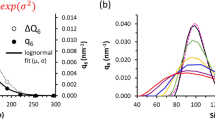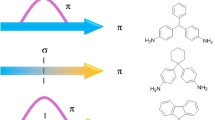Abstract
An analytical solution for the calculation of the charge carrier density of organic materials with a Gaussian distribution for the density of states is presented and builds upon the ideas presented by Mehmetoğlu (J Comput Electron 13:960–964, 2014) and Paasch et al. (J Appl Phys 107:104501-1–104501-4, 2010). The integral of interest is called the Gauss–Fermi integral and can be viewed as a particular type of integral in a family of the more general Fermi–Dirac-type integrals. The form of the Gauss–Fermi integral will be defined as
where \(G\left( \alpha ,\beta ,\xi \right) \) is a dimensionless function. This article illustrates a technique developed by Selvaggi et al. [3] to derive a mathematical formula for a complete range of parameters \(\alpha \), \(\beta \), and \(\xi \) valid \(\forall \) \(\alpha \) \( \varepsilon \) \( {\mathbb {R}} \ge 0\), \(\forall \) \(\beta \) \(\varepsilon \) \( {\mathbb {R}} \), and \(\forall \) \(\xi \) \(\varepsilon \) \( {\mathbb {R}} \).




Similar content being viewed by others
References
Mehmetoğlu, T.: Analytical evaluation of charge carrier density of organic materials with Gauss density of states. J. Comput. Electron. 13, 960–964 (2014)
Paasch, G., Scheinert, S.: Charge carrier density of organics with Gaussian density of states: analytical approximation for the Gauss–Fermi integral. J. Appl. Phys. 107, 104501-1–104501-4 (2010)
Selvaggi, J.A., Selvaggi, J.P.: The analytical evaluation of the half-order Fermi–Dirac integrals. Open Math. J. 5, 1–7 (2012)
Muccini, M.: A bright future for organic field-effect transistors. Nat. Mat. 5, 605–613 (2006)
Malachowski, M.J., Żmija, J.: Organic field-effect transistors. Opto Electron. Rev. 18(2), 121–136 (2010)
Drury, C.J., Mutsaers, C.M.J., Hart, C.M., Matters, M., de Leeuw, D.M.: Low-cost all-polymer integrated circuits. Appl. Phys. Lett. 73, 108–110 (1998)
Borsenberger, P.M., Weiss, D.S.: Organic Photoreceptors for Xerography. Marcel Dekker, New York (1998)
Buckley, A.: Organic Light-Emitting Diodes (OLEDs): Materials, Devices and Applications. Woodhead Publishing Limited, Oxford (2013)
Brabec, C.J., Sariciftci, N.S., Hummelen, J.C.: Plastic solar cells. Adv. Funct. Mater. 11, 15–26 (2001)
Bassler, H.: Charge transport in disordered organic photoconductors a Monte Carlo simulation study. Phys. Status Solidi B 175, 15–56 (1993)
Wolfram Research, Inc., MATHEMATICA, version 11.1, Wolfram Research, Inc., Champaign, Illinois, (2011)
Goano, M.: Algorithm 745: computation of the complete and incomplete Fermi–Dirac integral. ACM Trans. Math. Softw. 21(3), 221–232 (1995)
Garoni, T.M., Frankela, N.E.: Complete asymptotic expansions of the Fermi–Dirac integrals \(F_{p}\left( \eta \right) =\frac{1}{\Gamma (p+1) }\int \limits _{0}^{\infty }\frac{\varepsilon _{p}}{1+\varepsilon ^{\varepsilon -\eta }}d\varepsilon \). J. Math. Phys. 42(4), 1860–1868 (2001)
Mohankumar, N., Natarajan, A.: On the very accurate numerical evaluation of the generalized Fermi–Dirac integrals. Comput. Phys. Commun. 207, 193–201 (2017)
Cody, W.J., Thacher, H.C.: Rational Chebyshev approximations for Fermi–Dirac integrals of orders -1/2, 1/2 and 3/2. Math. Comput. 21(97), 30–40 (1967)
Chevillard, S., Revol, N.: Computation of the error function erf in arbitrary precision with correct rounding. In: Proceedings of RNC 8 8th Conference on Real Numbers and Computers, pp. 27–36 (2008)
Chevillard, S.: The functions erf and erfc computed with arbitrary precision and explicit error bounds. Inf. Comput. 216, 72–95 (2012)
Çopuroğlu, E., Sözen, S., Yamçıçıer, A.: Analytical evaluation of heat capacities of structural stainless steels by using \(n\)-dimensional integer and noninteger Debye functions. Int. J. Steel Struct. 17(2), 739–742 (2017)
Çopuroğlu, E., Tural Mehmetoğlu, T.: Full analytical evaluation of the Einstein relation for disordered semiconductors. IEEE Trans. Elect. Dev. 62(5), 1580–1583 (2015)
Acknowledgements
The author would like to express his thanks to Jerry A. Selvaggi for pointing out the connection between Fermi–Dirac-type integrals and real convolution. His observation has allowed the author to analytically evaluate a wide range of seemingly intractable integrals.
Author information
Authors and Affiliations
Corresponding author
A Appendix
A Appendix
A derivation of the Gauss–Fermi function begins with (8) rewritten below.
Rewrite (14) as follows
The denominators in each of the integrals in Eqs. (15) can be expanded in a binomial expansion. Similar methods can be found in Çopuro ğlu et al. [18, 19]. Each expansion results in a convergent integral within its limits of integration. This expansion leads to the following result.
Equation (16) can now be transformed into a more recognizable form. Define the following:
In (17), let \(y^{2}=\alpha \left( x-\beta \right) ^{2}\). This results in the following expression.
where \(\hbox {Erf}(\cdot )\) is the error function. In (18), let \(y=x-\beta \). This results in the following expression.
In (22), let \(v^{2}=\alpha \left( y-\frac{p}{2\alpha }\right) ^{2}\). This results in the following expression.
The identical steps used in deriving \(g_{1}\left( \alpha ,\beta ,\xi \right) \) are used in deriving \(g_{2}\left( \alpha ,\beta ,\xi \right) \). The expression is given as
Likewise, \(g_{3}\left( \alpha ,\beta ,\xi \right) \) can be written as follows:
In (25), let \(u=x+\beta \). This leads to
In (26), let \(v^{2}=\) \(\alpha \left( u+\frac{p}{2\alpha }\right) ^{2} \). This transformation leads to the following:
The Gauss–Fermi function is now given by
This proves the result given by (10) and is valid \(\forall \) \( \alpha \) \(\varepsilon \) \( {\mathbb {R}} \ge 0\), \(\forall \) \(\beta \) \(\varepsilon \) \( {\mathbb {R}} \), and \(\forall \) \(\xi \) \(\varepsilon \) \( {\mathbb {R}} \ge 0\). The Gauss–Fermi function valid \(\forall \) \(\alpha \) \(\varepsilon \) \( {\mathbb {R}} \ge 0\), \(\forall \) \(\beta \) \(\varepsilon \) \( {\mathbb {R}} \), and \(\forall \) \(\xi \) \(\varepsilon \) \( {\mathbb {R}} \le 0\) follows a similar proof.
Rights and permissions
About this article
Cite this article
Selvaggi, J.P. Analytical evaluation of the charge carrier density of organic materials with a Gaussian density of states revisited. J Comput Electron 17, 61–67 (2018). https://doi.org/10.1007/s10825-017-1113-5
Published:
Issue Date:
DOI: https://doi.org/10.1007/s10825-017-1113-5




